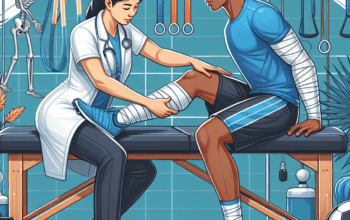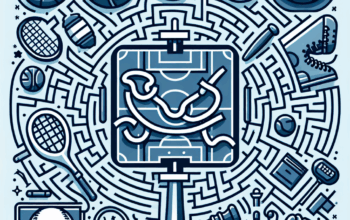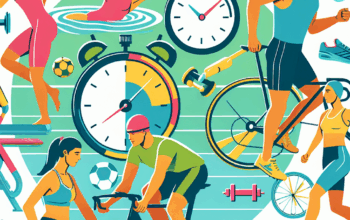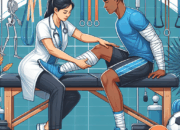Introduction
In the ever-evolving world of sports, injuries can be a significant setback for athletes, affecting not only their performance but also their mental resilience. Innovations in sports injury rehabilitation techniques are reshaping how athletes recover, ensuring they return to their peak performance faster and more effectively. Drawing from advancements in technology and therapy, these innovative strategies are designed to enhance recovery times, reduce pain, and prevent future injuries. By 2025, a myriad of groundbreaking techniques has emerged, transforming the landscape of sports rehabilitation.
Integrative Approaches to Sports Injury Rehabilitation
The integration of various therapeutic modalities has revolutionized sports injury rehabilitation. No longer confined to traditional practices, rehabilitation now combines physical therapy, chiropractic care, massage therapy, and even acupuncture. This multifactorial approach enables personalized treatment plans tailored to the specific needs of each athlete. Evidence suggests that combining these techniques not only enhances recovery but also promotes overall well-being, reducing the likelihood of re-injury.
Moreover, the inclusion of mental health resources has gained traction, recognizing that psychological factors significantly influence recovery. Techniques such as visualization, cognitive behavioral therapy, and mindfulness meditation are proving invaluable. These integrative approaches instill confidence in athletes, allowing them to overcome psychological barriers that often accompany injuries. By addressing both physical and mental health, sports injury rehabilitation becomes a holistic experience, fostering resilience and promoting a quicker return to competition.
Wearable Technology in Rehabilitation
Wearable technology has become a game-changer in the field of sports injury rehabilitation. Devices like smartwatches and fitness trackers provide real-time data on an athlete’s performance metrics, such as heart rate, movement patterns, and even muscle fatigue levels. By analyzing this data, rehabilitation specialists can develop targeted interventions that enhance recovery. For instance, athletes can be guided through specific exercises informed by their real-time biomechanical data, ensuring they are not only safe but also effectively rehabilitating their injuries.
In 2025, advancements have extended beyond simple tracking. With the integration of artificial intelligence, predictive analytics allow for preemptive adjustments to rehabilitation programs based on an athlete’s physiological responses. This means that rehabilitation becomes more proactive rather than reactive, addressing potential problems before they escalate. Wearable technology has thus shifted rehabilitation from a one-size-fits-all model to a personalized experience, optimizing recovery for each athlete.
Regenerative Medicine in Sports Rehabilitation
Regenerative medicine represents one of the most significant advancements in sports injury rehabilitation techniques. The use of stem cell therapy and platelet-rich plasma (PRP) injections has gained widespread popularity among elite athletes. These techniques promote the body’s natural healing processes, accelerating recovery from acute and chronic injuries. In 2025, researchers have further refined these procedures, enhancing their effectiveness and safety.
Another innovative development in regenerative medicine is the use of exosomes, which are naturally occurring vesicles that facilitate communication between cells. Exosomes derived from stem cells are being investigated for their potential to accelerate tissue repair and regeneration. By administering these biological agents, athletes can potentially heal faster from injuries that previously required extensive downtime. As research continues to unfold, the application of regenerative medicine in sports rehabilitation heralds a new era of recovery strategies that empower athletes to regain their competitive edge without the lengthy rehabilitation process.
Furthermore, the effectiveness of these regenerative therapies can be significantly improved when combined with other rehabilitation techniques. For example, integrating physical therapy with regenerative treatments can help improve muscle strength and functional mobility, enhancing the overall outcome. This multi-faceted approach demonstrates how regenerative therapies not only provide immediate relief but also contribute to long-term recovery and injury prevention.
Virtual Reality and Augmented Reality in Rehabilitation
Virtual reality (VR) and augmented reality (AR) have emerged as groundbreaking tools in sports injury rehabilitation, offering immersive environments for athletes to engage in their recovery. By 2025, rehabilitation programs incorporate VR simulations that mimic real-life athletic scenarios, allowing athletes to practice movements while recovering from injuries. This not only maintains their skills but also enables them to gradually reacclimate to the demands of their sport without the risk of exacerbating their condition.
AR also plays a critical role in rehabilitation by providing athletes with real-time feedback and guidance during their recovery exercises. Wearable devices equipped with AR functionalities can project accurate posture corrections, movement mechanics, and even visualization cues right in front of the athlete. This technology is especially valuable in teaching proper movement patterns that are crucial for avoiding future injuries, ensuring that athletes not only recover but also improve their overall performance quality.
The cognitive benefits of VR and AR integration cannot be overlooked. Engaging in these virtual platforms helps maintain an athlete’s mental sharpness and focus, which is often challenged during extended recovery periods. By combining physical and cognitive rehabilitation through immersive experiences, athletes are better equipped to handle the psychological stresses associated with being sidelined, fostering a holistic recovery process that addresses both the body and the mind.
Telehealth and Remote Rehabilitation Delivery
The rise of telehealth has transformed how sports injury rehabilitation is delivered, particularly in the wake of the global pandemic. By 2025, remote rehabilitation services are not only a necessity but a preferred method for many athletes. Through telehealth platforms, athletes can consult with physical therapists and rehabilitation experts from the comfort of their homes. This convenient setup eliminates barriers to access, allowing more athletes to receive timely intervention.
Telehealth rehabilitation sessions often incorporate video analysis of exercises, allowing therapists to provide immediate feedback and adjustments. Utilizing smartphone apps, athletes can track their progress, adhere to rehabilitation protocols, and communicate directly with their therapists in real-time. This two-way interaction ensures that therapists remain closely involved in the recovery process, which enhances accountability and motivation for athletes.
Furthermore, telehealth opens up opportunities for collaboration among health care providers. Sports teams can coordinate care for injured players more effectively, ensuring a comprehensive approach to rehabilitation involving coaches, nutritionists, and mental health professionals. This interconnected web of support is pivotal in creating an environment conducive to recovery and prevention, increasing the likelihood of athletes returning to play not just healed, but also improved.
Conclusion
Innovations in sports injury rehabilitation techniques are reshaping how athletes recover, combining modern technology, integrative therapies, and personalized approaches. As we stand in 2025, the landscape of rehabilitation continues to evolve, incorporating advancements in regenerative medicine, virtual reality, and telehealth to foster a holistic recovery experience. Athletes can now leverage these transformative techniques to recover more effectively and efficiently, ensuring they return to their sport stronger and more resilient. The ongoing commitment to research and development in this field promises to lead to even more groundbreaking advancements, ultimately transforming the future of sports rehabilitation.
FAQs Section
What are the latest advancements in sports injury rehabilitation techniques?
Recent advancements include wearable technology for data collection, regenerative medicine such as stem cell therapy, and the use of virtual and augmented reality for immersive rehabilitation experiences.
How effective is telehealth for sports injury rehabilitation?
Telehealth is highly effective as it provides convenient access to rehabilitation services, allows for real-time feedback, and ensures continuous support from healthcare providers during recovery.
What role does mental health play in sports injury rehabilitation?
Mental health is crucial, as psychological factors can influence recovery rates. Integrating cognitive behavioral therapy and mindfulness techniques supports athletes in overcoming mental barriers associated with injury.
Can regenerative medicine completely heal sports injuries?
While regenerative medicine offers significant benefits in accelerating recovery and healing, the effectiveness varies by individual and injury type. It’s often most impactful when combined with traditional rehabilitation methods.
How do athletes prepare for rehabilitation after an injury?
Preparation includes setting clear rehabilitation goals, engaging in open communication with healthcare providers, adhering to prescribed treatment plans, and focusing on both physical and mental aspects of recovery.












